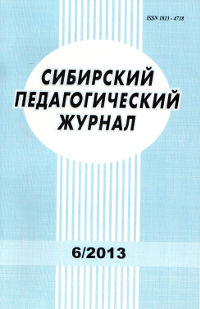Visual Image and Visualised Text as Means of Visualisation in the Educational Process at a Higher Education Institution
1. Inishev, I., 2012. “Iconic turn” in the sciences of culture and society. Logos, no. 1 (85), pp. 184–211. (In Russ.)
2. Mitchell, W. J. T., 1994. The Pictorial Turn. In: Mitchell W. J. T. Picture Theory. Essays on Verbal and Visual Representation. Chicago & London: The University of Chicago Press, pp. 11–34. (In Eng.)
3. Boehm, G., 1994. Die Wiederkehr der Bilder. Was ist ein Bild?, ed. by G. Boehm. Munich: Wilhelm Fink Publ., pp. 11–38. (In German)
4. Mitchell, W. J. T., 2017. Iconology. Image. Text. Ideology. Moscow, Ekaterinburg: Kabinetnyi uchenyi Publ., 240 p. (In Russ.)
5. Bal, M., 2012. Visual essentialism and the object of visual studies. Logos, no. 1 (85), pp. 212–249. (In Russ.)
6. Vasilievа, M. R., 2015. Visual communication: becoming the discipline. Siberian pedagogical journal, no. 4, рр. 34–39. (In Russ., abstract in Eng.)
7. Shalyutina, N. V., 2016. Visual methodology: main conceptual approaches. Bulletin of Lobachevsky state university of Nizhni Novgorod. Social sciences, no. 3 (43), pр. 120–124. (In Russ., abstract in Eng.)
8. Gabova, M. V., 2017. Visual culture of modern society (experience of typology). Human. Culture. Education, no. 2 (24), pp. 30–40. (In Russ., abstract in Eng.)
9. Erokhina, T. I., 2023. Aesthetics of visual in modern culture: the phenomenon of a quiet book. Yaroslavl pedagogical bulletin, no. 4 (133), pp. 195–203. (In Russ., abstract in Eng.)
10. Ishchenko E. N., 2016. “Visual turn” in modern culture: experiences of philosophical reflection. Proceedings of Voronezh State University. Series: Philosophy, no. 2 (20), pp. 16–27. (In Russ., abstract in Eng.)
11. Medova, A. A., 2023. The problem of image: phenomenological context. Tomsk State University Journal of Philosophy, Sociology and Political Science, no. 72, pp. 5–15. (In Russ., abstract in Eng.)
12. Medova, A., 2023. Auditory image: phenomenological localization of the problem. HORIZON. Studies in phenomenology, no. 12 (2), pp. 531–553. (In Russ., abstract in Eng.)
13. Romm, T. A., 2007. Social education: evolution of theoretical images. Novosibirsk: Nauka Publ., 380 p. (In Russ.)
14. Vikhman, V. V., 2023. Education and its theoretical images: transdisciplinary dimension. Novosibirsk: NSTU Publ., 290 p. (In Russ.)
15. Katkova, A. L., Strelnikov, S. S., 2022. Directions of visualization’s using in professional education. The Humanities and Education, no. 13 (3–51), pp. 60–66. (In Russ., abstract in Eng.)
16. Tikhonova, I. V., Pilyuk, N. N., Barcho, O. F., 2020. Conceptual foundations of learning visualization. Problems of modern pedagogical education, no. 67–3, pp. 215–217. (In Russ., abstract in Eng.)
17. Aranova, S. V., Andreeva, N. D., Shurilova, T. B., Panichkin, A. V., 2021. The phenomenon of visualization in education. St. Petersburg: Asterion Publ., 134 p. (In Russ.)
18. Inishev, I., 2010. Phenomenology as a Theory of Image. Logos, no. 5 (78), pp. 196–204. (In Russ.)
19. Peirce, Ch., 2000. Issues of pragmatism. Vol. 2. Logical foundations of the theory of signs. St. Petersburg: Aleteia Publ., 352 p. (In Russ.)
20. Inishev, I. N., 2011. The Interplay of the Material and the Semantic within Iconic Experience. Tomsk State University Journal of Philosophy, Sociology and Political Science, no. 4 (16), pp. 86–93. (In Russ., abstract in Eng.)
21. Inishev, I. N., 2011. Spatiality of imagery. Topos. The Journal Philosophy and Cultural Studies, no. 1, pp. 116–125. (In Russ., abstract in Eng.)




